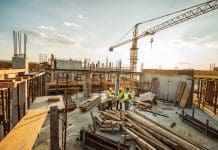The outlook for construction in 2024 is mixed and clients need to be prepared to navigate a complex market when it comes to balancing opportunities with cost, says Martin Sudweeks, UK managing director of cost management at Turner & Townsend
On the one hand, public investment in infrastructure remains high. While last year saw the cancellation of the northern leg of HS2, key parts of the programme are still underway, and £20bn has been earmarked for spending on transport across the North of England.
Some specialist construction areas, including refurbishment and retrofit, are also growing strongly.
On the other, construction’s output increased by just 2.5% over the course of 2023, representing a marked slowdown from its expansion of 6.5% in 2022.
Meanwhile, concerns over the sector’s skills gap are mounting and the prices of many key materials remain elevated, with the price of concrete rising by 5% during Q3 2023.
These cost pressures mean that tender prices remain on the rise for construction in 2024, with our latest UK Market Intelligence report forecasting a 2.7% increase in prices for real estate and a 4.5% hike for infrastructure.
The upcoming general election brings a new wave of uncertainty for construction in 2024
Add to this the sector’s shifting priorities, and the picture becomes even more complicated. As the industry increasingly focuses on sustainability, it’s not just financial costs that need to be monitored.
Clients are also under increasing pressure to calculate and reduce their carbon emissions.
Collectively, these factors are constraining investor confidence. This is set to be shaken further as the upcoming general election ushers in a fresh wave of political uncertainty. This comes at a challenging time for the industry – the National Infrastructure Commission stressed last year that private sector investment must increase by up to £20bn by 2050.
In the face of these issues, the sector must not forget the role that it can play in boosting productivity and attracting investment. To make this happen, digital technologies will be its most crucial tool. Building highly skilled teams that are equipped to use new systems and to measure cost and carbon data will require commitment. However, this will pay off as the sector’s biggest challenges, both new and old, are addressed.
Streamlining the supply chain through digital delivery
One of the many obstacles that digital tools will be instrumental in tackling is the adversarial nature of relationships across the supply chain.
The model whereby clients and suppliers work towards their own narrowly focused objectives limits efficiency and curtails teams’ ability to deliver work on time and to budget.
In this context, the move by some clients towards more collaborative ways of working, as already increasingly seen in major programmes and regulated industries including the water sector, is a welcome one.
The support that digital technologies can provide in this shift is invaluable. By capturing data across the supply chain, as well as making it visible and accessible, the whole team will have oversight of its progress.
Issues can be addressed as they arise and costs, both environmental and financial, can be kept in check.
Better decision-making using data and digital tools
Making data readily available has more advantages than just increasing visibility. It will also help to inform decisions over design strategies, which are becoming more important against a backdrop of economic and policy uncertainty.
Cost pressures are leading some in the sector to revert to traditional procurement models and commissioning more detailed designs before putting construction work out to tender.
Rowing back from design and build in this way is not without its drawbacks, however – and clients need to be confident they are not missing out on the experience of contractors throughout the design phase.
Digital delivery can help square this circle. By helping clients to plan projects with more accuracy, digital tools enable them to better understand which design strategies are most appropriate and to exercise flexibility in choosing their route to market.
Skills must be built to reap the rewards of digitalisation
As the benefits of digitalisation come to the fore, investment is not only needed in new technology but also in the skills to use it to its full potential.
This will require creative, long-term thinking about how the industry positions itself to diversify its skills base.
Competent digital teams, which are equipped to address the needs both of today and tomorrow, must be built up and nurtured.
To do this effectively, new talent pools and cohorts must be drawn upon and attracted to the sector. In the new, digital age of construction, sustainability experts and data scientists will play an essential role alongside the longstanding expertise of disciplines such as cost management.
By fostering the talent and expertise needed to operate new technologies, the sector can take advantage of the opportunities presented by digital tools.
Facilitating cooperation, improving visibility and simplifying decision-making are just some of the benefits of investing in digital – increasing productivity and driving investment will follow.
Martin Sudweeks
UK managing director of cost management
Turner & Townsend
Tel: +44 (0)20 7544 4000

















